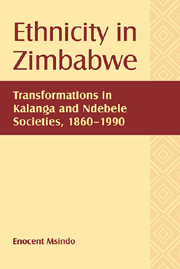Book contents
- Frontmatter
- Contents
- List of Illustrations
- Acknowledgments
- List of Abbreviations
- Note to the Reader
- Introduction
- 1 Ethnicity and Identities in Matabeleland
- 2 Domination and Resistance: Precolonial Ndebele and Kalanga Relations, 1860–93
- 3 Remaking Communities on the Margins: Chieftaincy and Ethnicity in Bulilima-Mangwe, 1893 to the 1950s
- 4 Ultraroyalism, King's Cattle, and Postconquest Politics among the Ndebele, 1893 to the 1940s
- 5 Language and Ethnicity in Matabeleland
- 6 Contests and Identities in Town: Bulawayo before 1960
- 7 Complementary or Competing? Ethnicity and Nationalism in Matabeleland, 1950–79
- 8 Postcolonial Terror: Politics, Violence, and Identity, 1980–90
- Conclusion
- Notes
- Selected Bibliography
- Index
- Rochester Studies in African History and the Diaspora
6 - Contests and Identities in Town: Bulawayo before 1960
Published online by Cambridge University Press: 05 February 2013
- Frontmatter
- Contents
- List of Illustrations
- Acknowledgments
- List of Abbreviations
- Note to the Reader
- Introduction
- 1 Ethnicity and Identities in Matabeleland
- 2 Domination and Resistance: Precolonial Ndebele and Kalanga Relations, 1860–93
- 3 Remaking Communities on the Margins: Chieftaincy and Ethnicity in Bulilima-Mangwe, 1893 to the 1950s
- 4 Ultraroyalism, King's Cattle, and Postconquest Politics among the Ndebele, 1893 to the 1940s
- 5 Language and Ethnicity in Matabeleland
- 6 Contests and Identities in Town: Bulawayo before 1960
- 7 Complementary or Competing? Ethnicity and Nationalism in Matabeleland, 1950–79
- 8 Postcolonial Terror: Politics, Violence, and Identity, 1980–90
- Conclusion
- Notes
- Selected Bibliography
- Index
- Rochester Studies in African History and the Diaspora
Summary
Background, Context, and the Argument
Bulawayo's colonial phase began in 1894, following the 1893 Anglo-Ndebele War, after which Lobengula burned down his capital and left. In the vicinity of Bulawayo were Ndebele settlements that were not quickly abandoned. However, those people whose homes fell within the town boundaries were rendered squatters, and their homes were recommended to be burned. Symbolically, the government erected its Government House, Cecil Rhodes's official residence, on the site of Lobengula's former palace. Since then, Bulawayo became Rhodesia's major industrial hub and the headquarters of Rhodesian Railways, with a high demand for industrial labor. In the early years, however, most of the local (Matabeleland) people were generally unprepared for town life, especially when it came to offering themselves for wage labor. Consequently, the new businesses in the town and its surrounding areas sought laborers from southern, eastern, and central Africa, and from among the Shona. Thus, Bulawayo began as a predominantly foreign town, from the viewpoint of the Ndebele and other peoples of Matabeleland, as it was inhabited in its core mainly by Africans of other ethnicities and different geographical origins, contrary to what Yoshikuni and Ranger have assumed. There were, of course—apart from Ndebele workers in the police, postal service, clerical service, and other occupations—a few prominent Ndebele inhabitants in town, some of whom were born in the “Native Location” (Makokoba) like Siphambaniso Manyoba, who became a prominent Ndebele activist, and others like Jojo Mkatjane, originally from the Shangani reserve, who by 1930 already appeared to have lost touch with the rural sensibilities of his home.
- Type
- Chapter
- Information
- Ethnicity in ZimbabweTransformations in Kalanga and Ndebele Societies, 1860-1990, pp. 136 - 178Publisher: Boydell & BrewerPrint publication year: 2012



